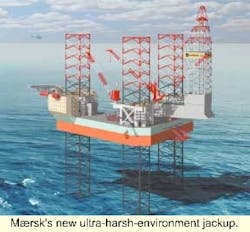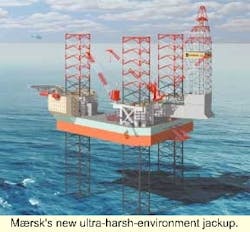Santa Fe ventures into deeper water
Santa Fe International's Board of Directors announced authorization for construction of two deepwater semisubmersibles and up to four jackups. In February, Santa Fe executed a letter of award to PPL Shipyard PTE, Ltd. of Singapore for the construction of two JU 2000 design high performance jackup rigs. The plan for construction calls for delivery of the first jackup in 24 months, followed by the succeeding jackups at 12-month intervals.
The rigs will cost approximately $125 million each and will be capable of drilling in 400 ft water depths in benign areas and 300-350 in harsh environments. Building the rigs on spec, Santa Fe is taking advantage of its strong financial position to prepare for increasing rig demand.
The timing and scope of this proposed project at the early stages of an industry upturn will place Santa Fe in a desirable position when the boom is in full swing.
The second element of the new-build plan is noteworthy because it constitutes a milestone for Santa Fe, a step out into deepwater with the construction of Santa Fe's first semisubmersibles capable of working in up to 7,500 ft. water depth.
These semisubmersibles will not be high-end harsh-environment rigs, but will be built for efficiency and versatility. Negotiations with several short-listed shipyards are ongoing, and a construction contract award is expected later this quarter.
The proposed construction plan is ambitious and indicates a departure for Santa Fe, who has had limited exposure to deepwater markets. According to Santa Fe, moving into deepwater has been a goal for some time.
Coflexip Stena readies subsea construction vessels
Coflexip Stena Offshore's CSO Constructor finally made its way last December to British shipyard Cammell Laird Tyneside for a conversion originally scheduled for April 2000. The work was postponed due to the vessel's heavy workload, but upgrading is now underway.
When work is complete, this subsea construction vessel will be able to install rigid lines with the M-J lay system or flexible lines and umbilicals, stored in a carousel under deck, using the vertical laying system to 4,900 ft water depth. A lengthened and widened deck will bring the CSO Constructor's pipeline payload to 3,000 metric tons. The vessel is scheduled for completion in April of this year.
Meanwhile, work continues on the newly built ultra-deepwater pipelay and subsea construction vessel CSO Deep Blue, moved to the Netherlands early this year to undergo unique pipelay equipment installation. Built for ultra-deepwater, the CSO Deep Blue is scheduled to begin operations in mid-year.
Chiles commissions two jackups
At the end of 2000, Chiles Offshore Inc. commissioned the construction of two Discovery-class rigs, what Bill Chiles, President and CEO, calls "ultra-premium class jackups." The rigs are Keppel FELS Mod V B jackup mobile offshore drilling units and are being designed and built by Keppel FELS, Singapore. These rigs are designed to work in water depths as shallow as 16 ft and up to 360 ft. A cantilevered drilling structure and substructure allows the unit to drill or workover wells on existing fixed production platforms.
Delivery dates for the two commissioned jackups are March 2002 and August 2002. An option exists for a third rig, but nothing definite is in place at present. Cameron Controls is supplying the blowout preventers for these two vessels.
Mærsk expands
Mærsk Supply Service has ordered two new multipurpose anchor handling tug supply vessels from Volkswerft Stralsund, Germany, for delivery in the first half of 2003. These two will be sister vessels to the Mærsk Assister and the Mærsk Attender, which were delivered from Volkswerft Stralsund last year.
Mærsk has also ordered two 17,500 BHP UT722L type anchor handling tug supply vessels from Langsten AS, Norway, for delivery in the first half of 2002. Both contracts contain options for additional vessels. This order for supply vessels comes on the heels of the second order placed by Mærsk Contractors for construction of an ultra-harsh-environment jackup. Hyundai Heavy Industries, Korea, will deliver both ultra-harsh-environment rigs to the North Sea or Canada next year (one in the second quarter and the other in the fourth quarter). Mærsk says these two new ultra-harsh-environment rigs will be able to operate in the most severe environments at water depths up to 492 ft.
Diamond Offshore's royal upgrade underway
Diamond Offshore's semisubmersible Ocean Baroness is undergoing an upgrade to fifth-generation capabilities at the Keppel FELS Limited shipyard in Singapore. Initial outfitting includes stability enhancements and self-contained chain/ wire mooring for operation in water depths to 6,000 ft with approximately 6,200 tons operating variable deck load, 15,000 psi blowout preventers, and riser with a multiplex control system. The Ocean Baroness upgrade is on schedule and should be complete by next February.
Brutus gets topsides
The hull for Shell's deepwater tension leg platform Brutus arrived at Aker's Ingleside yard in Texas on January 29 following a two-month trek from the Daewoo fabrication yard in South Korea. The hull will be integrated with the five topside modules currently being fabricated by McDermott in Amelia, Louisiana. The completed structure will be towed to its permanent location in Green Canyon Block 158 in the Gulf of Mexico in the second quarter of this year. First oil and gas production is expected in the third quarter 2001.
Ocean Rig results
According to ABB Offshore Systems AS, Ocean Rig's first rig Leiv Eiriksson was 98.2% complete as of January 21, 2001, and was due to leave the yard for sea trials in the beginning of March. ABB estimates final delivery of the rig in April. The Eirik Raude was about 85% complete at the end of January. Estimated departure from the yard for sea trials is the second quarter of this year.
Banff complete
Petroleum Geo-Services ASA announced that the upgrade on the Ramform Banff is now substantially complete. Company sources say the work performed on the Ramform Banff during this shipyard stay will solve the problems that have previously limited production during harsh weather conditions. The Ramform Banff was scheduled to depart the shipyard and be ready for production early this year.
Atwood upgrades rigs
Following completion of its contract with British-Borneo in January, the Atwood Hunter moved to a US shipyard for an increase in its water depth drilling capacity as well as other upgrades. The upgrades were expected to take four or five months to complete.
Upgrades continue on the Atwood Eagle, which will be able to work in 5,000 ft water depth on completion of the work. The $80 million in upgrades to the Eagle should take two or three more months to complete.

